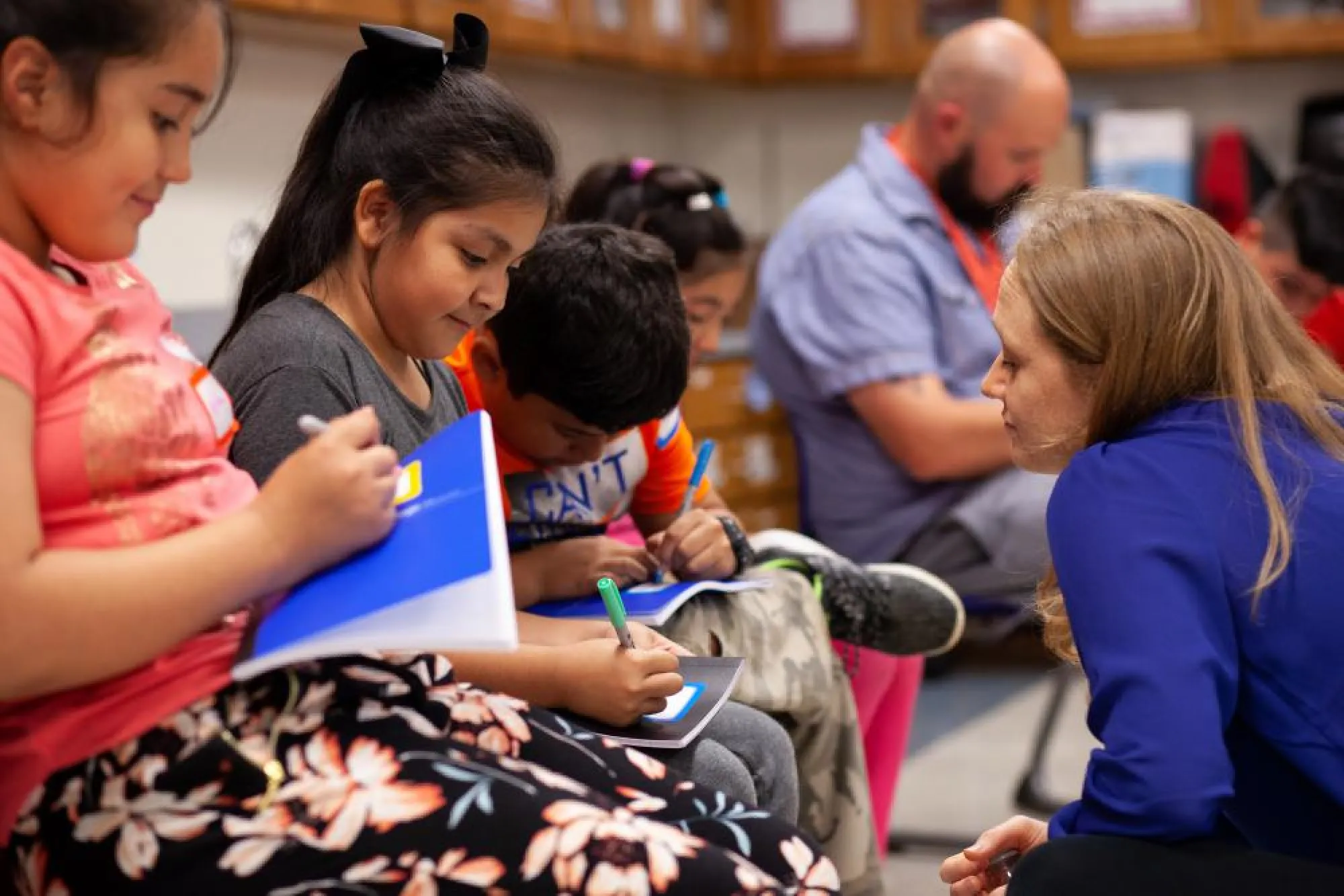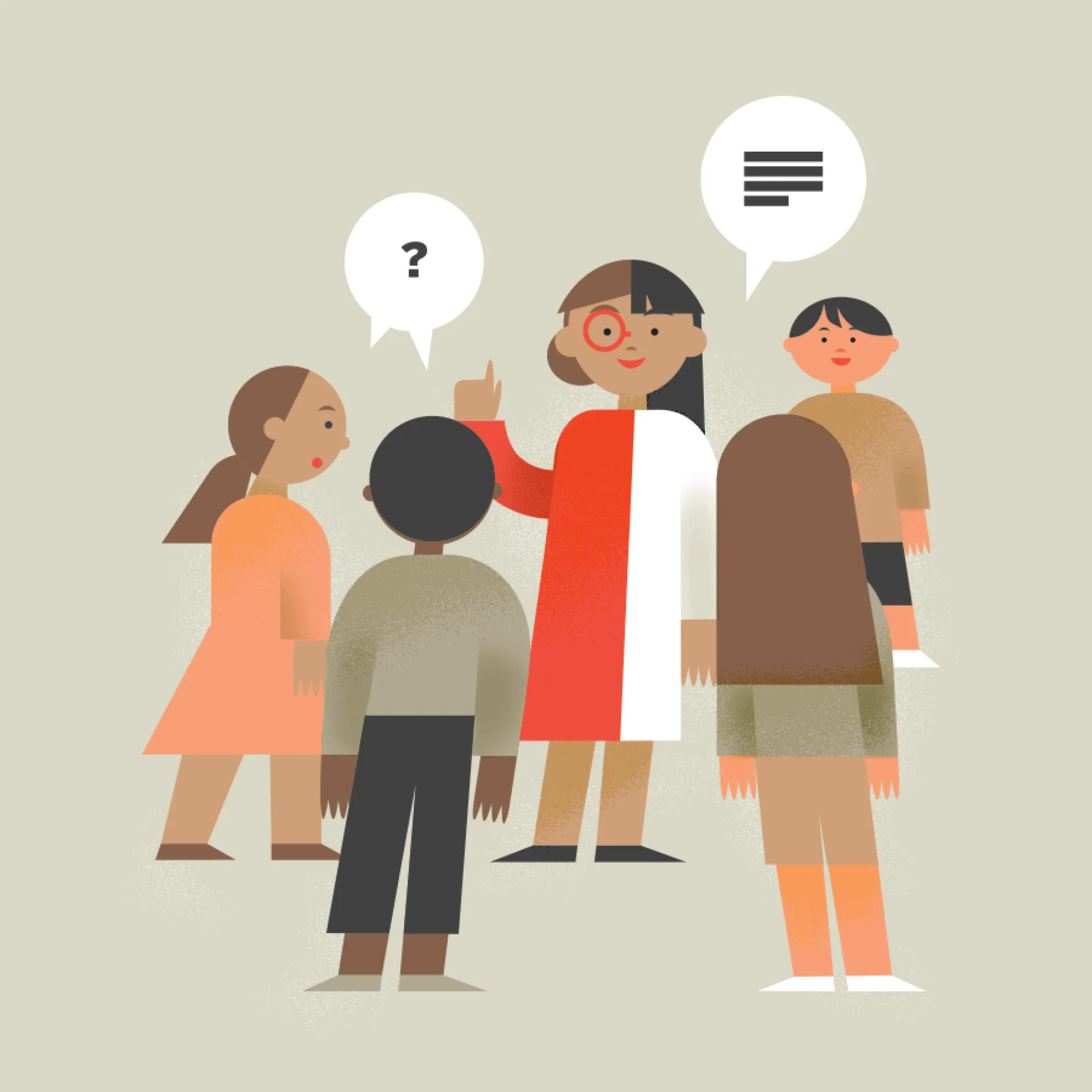Why Arts Are the Future of K-12 Education

Research shows that UT's Drama for Schools improves engagement and learning outcomes, raises test scores and increases attendance (Oh, and it's also more fun for students and teachers)
by Alicia Dietrich
***
In many school districts, kids who are struggling in a core subject such as math are often pulled from their arts classes to make time for a remedial math class. In other words, these students are moved from a class they probably like to one they probably hate.
UT’s Drama for Schools is working to change that model. Developed by Associate Professor Katie Dawson in response to arts education cuts and testing-focused teaching approaches during the early No Child Left Behind era, the program offers teachers new tools to engage students by using theatre and creative body-based learning techniques to teach non-arts subjects.
When Dawson was collaborating with a math teacher in Victoria, Texas, they designed a lesson for students struggling to understand how to solve for the area of a two-dimensional composite shape. She brought a large length of string to the class and challenged students to see whether they could silently work together to create a two-dimensional triangle with the string using every student in the class. Once they created the triangle with the string, she asked them to prove to her that it was a triangle—inviting them to use mathematical vocabulary such as vertex, angle and side to make their arguments.
“Then we asked, ‘What is the perimeter of our triangle? How can you measure it using informal units of measurement?’” says Dawson. “Students used their feet, their hands. They found wonderful, creative ways to determine the perimeter. Next, we asked, ‘Well, now that you know the perimeter, how can you use this information to figure out the area?’ So, through a short creative strategy, we basically reviewed and rehearsed two key geometric formulas. It was fun. And, we could easily assess who understood the concepts and re-teach where necessary.”
Next, Dawson built on the string activity by introducing an article about Google’s new offices in New York.
“We read over the article together and talked about what it would be like to work at Google and why they were designing offices with walls you could write on or a bar where you could have your coffee,” says Dawson. “And we concluded that certain kinds of work environments may help employees to be more innovative and to create new things. We also decided that Google might make more money when their employees are happy and productive.”
Dawson and the teacher then asked the students to imagine that Google was going to redesign their school and reimagine their space. The math teacher then stepped into the role of an inept architect who was assigned to design the flooring for the new school. The teacher pulled out plans that included composite shape problems the students could not answer on a prior test. Working in role, the teacher pretended to not know what she was doing. (“I only know how to lay out triangle- and square-shaped flooring! But, these rooms have shapes I don’t understand!”) The students then stepped in to help her do the math needed to calculate the area of the rooms by breaking the composite shapes into squares and triangles, then solving for area. Then the students designed the learning spaces they thought would support creative and innovative thinking and selected flooring and calculated amounts needed for each space. Once finished, students presented their plans to the principal of their school.
On the students’ next test on area of composite shapes, their grades improved.
“When students understand why they are learning something, when they explore a concept using their bodies through an authentic situation or story, engagement increases, and the concept is more likely to be understood and remembered,” says Dawson.

Dawson has a theatre background from her undergraduate years at Northwestern University, and she worked as an actor and as a teaching artist (a practicing artist with pedagogy and education training) for a number of years in Los Angeles, which led to jobs in museum education, television production and teaching.
Dawson’s work as a teaching artist helped her better understand some of the challenges of bringing theatre techniques to the classroom for non-theatre subjects, and she realized there was a gap in the literature and research in that area. So, she applied to graduate school in the Department of Theatre and Dance’s Theatre for Youth and Communities (DTYC) program to study with Professor Sharon Grady. While she was in graduate school, Dawson started doing work that would evolve into UT’s Drama for Schools program, a professional learning model that trains teachers to integrate the arts into subjects such as math, English/language arts and science to improve student outcomes.
“After my undergraduate theatre education degree, I spent time as a generalist classroom teacher and as a museum theatre educator. I found that I was constantly using my drama/theatre skills to increase engagement in my classroom,” says Dawson. “I found that other generalist teachers wanted to know more about what I was doing and how they could learn to use the arts across the curriculum in their classrooms.”
The Drama for Schools program offers summer workshops for teachers every year to train them in a method of arts integration called drama-based pedagogy. Thanks to funding from the Rea Charitable Trust, the program has expanded. Dawson and her team, including Assistant Professor of Instruction and Drama for Schools Coordinator Lara Dossett also work directly with school districts through multiyear partnerships to research and improve student and teacher outcomes. Dawson has worked with many school districts across Texas during the past decade, and for the past five years she’s been traveling back and forth between Texas and Adelaide, Australia, as part of a partnership with the arts and culture sector, the South Australian Department for Education and the University of South Australia to teach these techniques to K-12 teachers in Australia.
Here in Texas, more school districts are adopting arts integration models across the state. In Central Texas, Drama for Schools has partnered with several school districts, including the Austin Independent School District (ISD) and Round Rock ISD.
“It's the best thing I've ever seen or been a part of,” says Greg Goodman, who worked with Dawson in his role as fine arts director in Austin ISD. He’s now implementing these strategies in Clear Creek ISD in his current role as the director of visual and performing arts. “Not only that. It's engaging the teachers at a higher level too. If they're not excited about what they're doing, then it's not going to be portrayed in the instruction. So, you've got everybody participating and performing at a higher level.”
Austin ISD partnered with Dawson and Drama for Schools to support the Creative Learning Initiative, a city-wide program that promotes arts-rich schools by ensuring that all students have access to all arts disciplines at all levels, supporting partnerships with local arts organizations across the city and using arts techniques and strategies in all non-arts subjects. The district offers a three-year training program for all teachers, and the first year was designed in partnership with MINDPOP and Drama for Schools.
“Drama for School’s Summer Institute provides a really intensive opportunity for teachers to transform their thinking, their mindset and their practice and really become leaders of the work at their campus level,” says John Green-Otero, Creative Learning Initiative coordinator in Austin ISD.
Green-Otero and his colleagues track and measure teacher and student outcomes as teachers implement these strategies in the classroom, and they’re seeing transformative results. The program is especially effective in improving student engagement and social emotional learning, the process by which people acquire and apply the skills to understand and manage emotions, set and reach goals, feel empathy for others, make good decisions and create and maintain positive relationships. In short, it helps students become better and more effective learners and humans.
They also see improved retention of information by the students.
“If the students are studying a particular subject, they can go home and talk in detail with their parents,” says Goodman. “You can walk into a classroom a week or two later, and when the teacher's doing a different strategy, they'll refer back to what they did two weeks ago, and the kids are raising their hands and saying, ‘I remember when ...’ It's just a level of detail they're retaining, their level of wanting more, not wanting to leave a subject. They want to find out more about it.”
Goodman and Green-Otero note that the techniques are especially effective for students who are socioeconomically disadvantaged or whose first language is not English. Although Green-Otero notes that they still have to test these assumptions, he says, “I generally feel that once you allow students to represent their understanding and explore their understanding in more than just a language-based way, they're able to engage more authentically with it.
“It really leverages the best practices of social constructivist theory, brain-based pedagogical practices, student learning expectations across a lot of AISD's standards of practice,” says Green-Otero. “It's such a versatile approach to instruction that it's able to work either naturally or with minor modifications for pretty much every demographic of learner. In an educational landscape where we're really valuing personalization of a student's education, giving them practices that let them explore content in ways that are meaningful to them, it has to be at the forefront of the conversation.”
The work that Dawson and Drama for Schools does is rooted in research and high-quality, rigorous instruction, and teachers are drawn to it because it gives them effective tools to improve learning outcomes and reinvigorate their teaching approach.
“We have teachers who are gravitating to this work because it's highly engaging,” says Green-Otero. “They see that transformation almost immediately in their students. Kids don't even recognize it as instruction in the traditional way. They're seeing it as they're having fun or they're playing a game. That's great.”
Green-Otero notes that their data shows that 98% of Austin ISD teachers say this professional learning experience is engaging and relevant, with a clear structure they can immediately apply to the classroom.
“We make the metric in the district: Try one strategy once a week. That's our baseline. The reason we did this was because we learned that if a teacher tries it once, it just transforms their practice, and suddenly they’re using that strategy throughout their entire curriculum. It goes from, ‘I do this thing once’ to ‘I do this thing every single day, six times.’ ”

Dawson and Dossett have been piloting new teacher professional development techniques that now include students as part of the training. Earlier programs brought in only teachers, but this new approach engages students directly alongside their teachers as part of the training. After piloting the work in Australia, they have been testing this new approach with Berkman Elementary School in Round Rock ISD, thanks to a grant from the Carolyn Bartlett Rice Family Foundation. They hope to expand the project to other schools in the district and apply for grant funding to grow the project.
Dawson’s work continues to expand beyond Texas and around the world. This summer, Dawson returned to Bosnia-Herzegovina at the request of the U.S. State Department to gather educators from a range of ethnic backgrounds to collaboratively work to improve student engagement and critical thinking in education. And, on campus, as a UT Provost Teaching Fellow, Dawson has been facilitating workshops for her UT colleagues to learn how to use these techniques in higher education.
“Katie is not your typical professor. She's the tops,” says Goodman. “The way she captures everybody's attention and her knowledge and her skill set and her love and compassion and passion for it, it's exciting to see. Every time I get to see or talk to her, I just get so excited about education and what it can do for kids.”
What does it look like to teach using drama-based techniques?

Hot Seating
A role-playing strategy in which someone (a student or a teacher) takes on the role of a character and answers questions from the audience about that person, based on textual evidence or other forms of research. Audience members can also assume roles (newspaper reporter, etc.) to ask their questions.
In action: In a lesson about weather patterns, a student might assume the role of meteorologist and take questions from classmates about the material covered in the lesson.

Sculptor Clay
A strategy in which students work together to visually represent a word, idea or character, with one individual serving as the “sculptor,” who moves the other individual serving as the “clay” into position.
In action: In a geometry lesson, students could be asked to “sculpt” a statue that represents different mathematical terms such as an acute triangle, parallel lines or a trapezoid.

Data Processing
An activity in which a group quickly and silently puts itself into a single line continuum based on visible or invisible characteristics (e.g., by height, smallest to tallest; by birthday month, January to December). Students can play from their own experiences or physical characteristics, or they can play “as if” they were a number, a fact, a date or event from history, etc.
In action: In a history lesson, students could be assigned cards with events and arrange their bodies in chronological order of the events.

